

on the trail of aboriginal cave paintings and engravings -- investigating their significance in landscape and culture
| Knowing almost nothing about aboriginal art and less about their works in rock (cave drawings, paintings and engravings), Andy and I set off in our rented graffittied camper van to explore, try to make sense and connect with some of these magical sites. We waved goodbye to our friends in Melbourne and headed out to the outback, considered by all Australians to be their backyard, but one that is underutilized by most. In fact, at all of the sites we visited, we were absolutely alone, with the exception of the first site, where we saw two people leaving as we arrived and at one of the last, where we were accosted by a Park Ranger. In the Flinders Ranges, about 200 kilometers north of Adelaide in South Australia, Andy and I explored three different sites, the Yourambulla Caves, Arkaroo Rock and Sacred Canyon, all ancestral homes to the Aboriginal society identifying itself as Adnyamathanha (the 'hills' people). Their life consisted of a harmonius and intimate relationship with their environment which held great spiritual significance. The paintings at these sites, dated at about 6000 years old, and the rock engravings, thought to be much older, possibly dating back tens of thousands of years are testament to the rich cultural heritage of these people. Individual artists of the works are not known (or important) since/many people participated in these ritualistic works over countless generations. Symbols found in some of the more recent paintings are said to relate to the various rituals and ceremonies of the Adnyamathanha people and some of the paintings were renewed during ceremonies held as recently as the 1940's. |
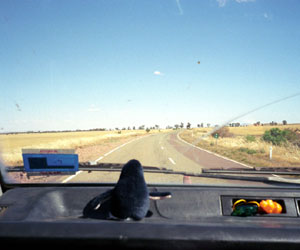
|
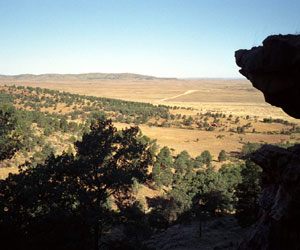
|
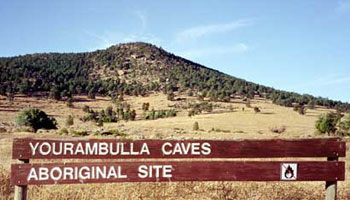
|
Swatting away flies, we hiked uphill about 20 minutes or so and found ourselves facing a fenced-off rock overhang. Aboriginal cave paintings (at least those that still exist today) are often found beneath overhangs like this. . The site, the largest cave with paintings in the region, lies behind an ugly metal cage of chain link fencing. Which we immediately disliked as it limits visual and physical access. The paintings appear to be caged for their own protection from prying hands, but the presence of the metal is unsubtle (and unsuitable) to say the least. Are the paintings behind this metallic mesh in order to keep out modern day graffiti writers, (we did see evidence of current names and dates scratched onto some sites) or to keep out modern day Aboriginals wanting to add to the work? Up until recent times, many of these sites were added to over and over again with each new generation adding to or simply going over the work that had come before them. We kept wishing that these protective devices were a bit more sensitive to and in keeping with their environments. However, looking past the visual disturbance, we were struck by the beauty of the site itself with it's bulbous boulders of red and black striations overlooking the valley. We then notice that the colors of the cave paintings mimic the colors of the landscape. No surprise, as many of the paints come from the earth itself: black either from manganese, charcoal, or charred bark perhaps all three, red and yellow ochre and white pipeclay. These pigments were mixed with animal fat and other binders in order to depict the tracks of emus and kangaroos as well as ceremonial motifs such as initiations. Circles often within other circles, lines, crosshatching and arrows symbolizing animal tracks and various rituals of youth initiation punctuate the undulations of the rock itself. Who made these remarkable markings and why? Were they bored doodlings created under these overhangs waiting for rain to stop? Were these made by people alone or by groups? Are these "Dreaming" stories or maps depicting good hunting spots? Many believe Aboriginal rock art portrays "the Dreaming" in which artists record the exploits of their ancestors, outlining rituals and explaining the creation of land formations, animals and plants. While we may never know the exact reasoning behind the markings, what can readily be seen is the cave provides shelter from the scorching sun and the rain, and possible predators such as rival aboriginal groups and eventually the Europeans. The markings themselves look like a secret language, Art Brut with childlike patterns that are beautiful and rhythmic. These enchanting works act as an oasis of visual splendor in a dry and arid land and our eyes kept boomeranging back and forth from the walls of the caves to the landscape and back again over to the cave walls. |
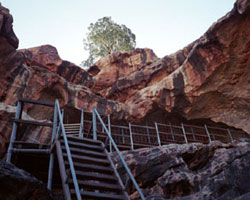
|
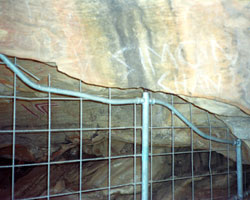
|
|
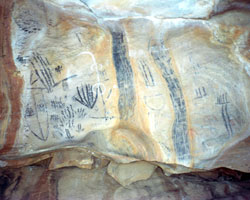
|
|
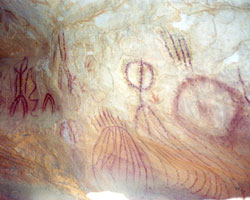
|
|
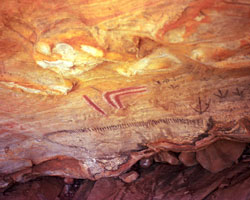
|
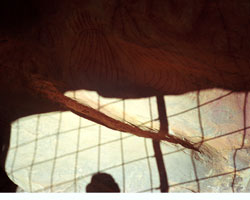
|
This second Yourambulla Caves site, another beautiful overhang, sits up on the hill, allowing aerial views of animal migrations. These two sites are weathered but seem to be holding up because the rock shelves protect the paintings from the elements, even in in this difficult climate. Perhaps the binders used for the pigments, such as emu fat and tree orchid sap are tough to break down, (unlike our van, but I'm getting ahead of myself). There is a constant drone of flies and Andy is swatting them away so I can write. The markings here are also caged. Sweat flows freely, and it is difficult to see the paintings through both the metal screens and the pouring perspiration. In an interesting (at least to us) twist, it appears as if the animals drawn on the cave walls are behind bars like animals in zoos. Here, hands are used as stencils, creating a pattern of handprints on the wall. This very identifiable human image creates an instant connection with the viewer. The simplified abstract symbols reminds me of Jung and his symbology. Agnes Martin and her use of striations also comes to mind. The shadow of bars mimic the painted striations on the wall but the hard steel shadows contrast the soft charcoal paintings. Strange that the soft charcoal will probably outlast the steel. |
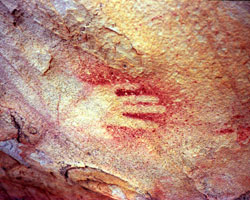
|
|
The paintings at Arkaroo are thought to be 6000 years old. This is another caged painting site like those at Yourambulla Caves. These sites strangely remind me of Da Vinci's Mona Lisa at Louvre in Paris. Here though, the works are behind iron instead of glass, and we were alone instead of in a big queue of people. Alone to enjoy this site consisting of inspiring rock formations of red earth with orange and purple rock striations. The lunarlike landscape of the cave walls complete with craters were mostly red ochre, white and charcoal paintings. The Flinders Ranges where Arkaroo Rock is sited is home to a significant red ochre deposit called Yarrakinna by the local people which is regarded as the blood of the sacred emu and was visited by Aboriginals from distant parts of Australia. |
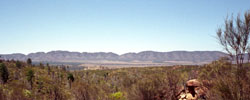
|
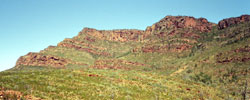
|
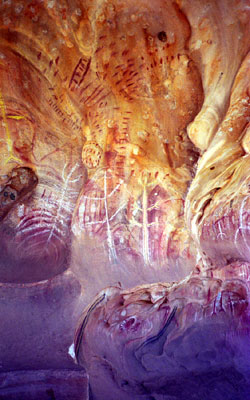
|
It was quiet, high noon, no flies buzzing. It looks like modern art, says Andy. And indeed it did, a curvilinear doodle dreamscape stream of consciousness evoking both Kandinsky and Pollock. The painted shapes cleverly echoing the natural architecture of the cave lend a fluidity which relates to the curves of the landscape. Layer upon layer of markings and symbols were laid down at this supercharged site, creating a frenzy of information. More than one artist seems to have been involved in these works, which are thought to have been part of an initiation ceremony. Perhaps these are the initiates doodling, waiting for the rain to stop, or for prey to emerge, or for evening to come, or for morning to appear in order to fulfill their sacred rituals? After leaving the caves we passed many kangaroos along the road and in the fields. The Adnyamathanha people believe ancestral beings created these fascinating creatures during the Dreaming (the creation story of the Aboriginal people). And this act of creation is one of the ideas that is thought to inhabit their cave paintings. Seeing them here, alongside the paintings, makes it all the more real and tangible for us. |
|
Walking the thirty minutes or so to this site was aesthetically very pleasing. This spot, also in the Flinders Range, consisting of engravings on rocks within a gorge, was refreshingly not behind bars. However, with minimal markings and limited clues, just finding the works was challenging and we almost longed for the ease of locating the caged works! This walk was similar to a treasure hunt with the treasures being the engravings. They were simple forms, often circles, made by banging one stone against another to create small marks which then coalesced into lines, or by rubbing a sharp stone to produce a groove. We found many simple circles here which represent camp (arngu). Circles with lines in and around them signify events at initiation ceremonies. We also found markings that depict ceremonial food (muka mai) which looks like roots or tubers that could be dug up out of the parched ground. Also seen were emu (warratyi) tracks alongside the camp symbols, as though the animals passed through these camps in search of water. Within the canyon itself, planes and angles were everywhere. I couldn't stop thinking about Duchamp's Nude Descending the Staircase as the planes of the valley walls appeared to be coming to life. En route to view the gouged circles and simple human forms, we passed a wallaby lying in the shade. Here again I felt this sighting somehow connected Andy and I with the makers of the works. The engravers could have passed the ancestors of these bizarre beasts. The wallaby, obviously not feeling this connection, bounced away. Leaving the South Australia and heading east to neighboring New South Wales, we ironically found ourselves broken down outside of Broken Hill. After spending a few days waiting for our van to be fixed and soaking up the Priscilla Queen of the Desert charms of this town in the middle of the outback, Andy and I were more than ready to resume control of our vehicle and once more head out into the sweltering outback on the trail of aboriginal markings. Our first stop was Mutawintji National Park just outside of Broken Hill. On the road to Mutawintji we encountered many emus running by the road, again linking us both to the older inhabitants of the area that relied on this game for their sustenance and to their representations of this flightless, yet graceful bird on the walls of caves. |
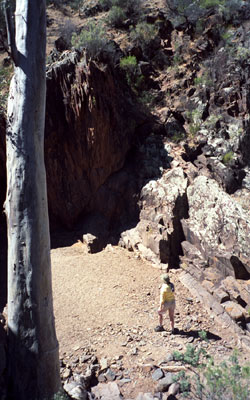
|
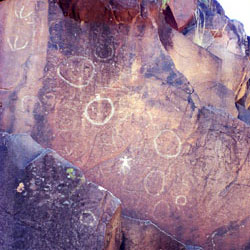
|
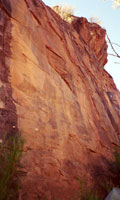
|
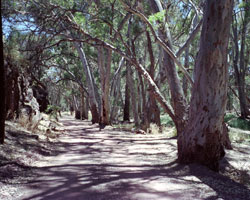
|
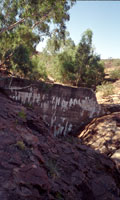
|
In Mutawintji we could only visit a few of the sites as the others were still actively being used by their Aboriginal inhabitants, the Malyankapa and Pandjikali peoples. The restricted areas act as ceremonial and ritual sites during part of the year and are only accessible by a hired guide in the remaining months. We decided on the Thaakalatjika (Wright's Cave) walk which included examples of both Aboriginal and European history, passed some of the beautiful gorges and majestic river gums (eucalyptus trees) the Park is known for, and was open to non-guided visitors. Here we happened upon a park ranger who seemed very keen to ensure that we did not trod upon the restricted area. He alerted us to the restricted status, then came by about 30 minutes later to make sure we were still not illegally trespassing.
Site 1Another rock cave overhang site, this one has all-white drawings punctuated with red ochre hand stencils. Many representations of splayed frogs (marta mara), sand goannas (thaakurlu) and the tracks of kangaroos (kirrpatja), thought to have been common sources of food for the people living in this area, are depicted on the walls. The drawings at this site are lower down than usual as the shady areas here are quite low to the ground. The most interesting thing about this site, however, is the addition of a European man's mark smack on top of the Aboriginal designs. William Wright, manager of Kinchega Station at Menindee visited Mutawintji in 1859 (LIX) and in 1862 (LXII) leaving his mark by carving his initials and the date in blue triangles not once but twice in the two different years he visited. He probably carved these marks in order to signify his hold onto the land, a concept of ownership foreign to the Aboriginal people who used the land, but did not own it. Both cultures, however, appeared to use tally marks to record significant events or the passage of time. Perhaps the tally marks show the number of ceremonies that had taken place there. The "Groonki Mark" (curved vertical lines in a row) which appears here, symbolizes a spiritually significant area. This special marking could have been done by a "Clever Man" (Miikika), said to be more than any other tribe member in contact with the Dreamtime and a leader of Aboriginal spiritualism. The clever man stick (Yarra), which resembles an upside-down simple broom and is also found represented at this site, is intended to beat the bad spirits out of the sick. The real Yarra was made from human hair and emu feathers. |
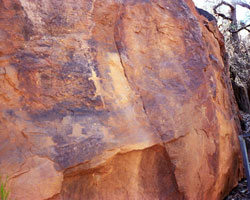
|
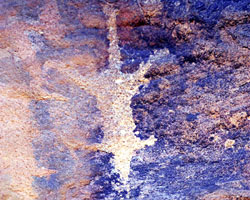
|
|
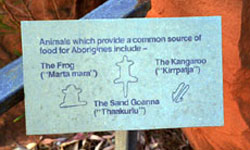
|
A sheer cliff face with no overhang constitutes this site. A modern sign incomprehensibly says "a dancing brolga". This cave is dominated by shadowy forms which look like a cross between human and alien, or perhaps they represent the backs of jumping kangaroos. The forms appear to echo some of the kangaroo tracks that we passed on our way to this site.
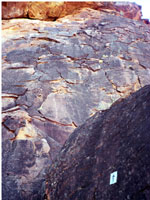 |
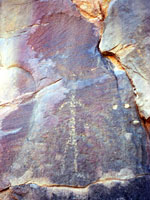 |
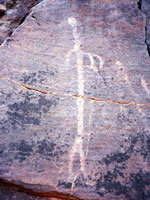 |
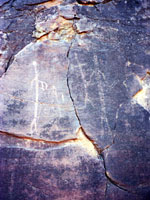 |
"The Crack Man" (Groonki Wimbija), representations of very tall thin elongated human forms, dominates this site. It is thought that the Crack Man came out of the cracks between the rocks above at night to protect the water holes. Andy believes that an old concrete dam also found at this site is a technological protector of the water supply.
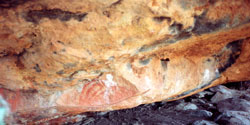
|
Travelling east towards Sydney, toward our final site and on our way out of the outback, we found ourselves on a dusty gravel road north of the Barrier Highway for 32 long kilometers. The paintings at this site were difficult to see for a number of reasons. One, they are extremely low to the ground and they are behind an extensive cage mechanism. Huge swarms of flies and very hot weather,(even at 6 p.m.), after an exhausting dusty drive on unpaved roads also made for a rough viewing experience. The site itself consists of a rocky ridge and semi-permanent waterhole. Although the waterhole was bone dry when we were there, it is one of the few in the area so this site was considered an important spot. Water was always an issue for the Aborigines (along with countless other groups past and present) and waterholes feature in many of the artworks as they not only provide water to the people but also to the animals which became food for the people. |
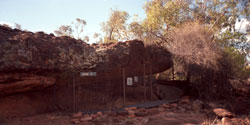
|
Site 1The paintings themselves were full of everything. Black, white, red, yellow were all used to depict human figures, mammals, reptiles, birds, linear patterns and abstracted designs. Lots of figures overlay one another under the overhang and it was hard to decipher distinct forms as they were all jumbled on top of one another. The paintings at this site seemed the closest to resembling modern graffiti, with layers upon layers that, created large multi-colored panels. |
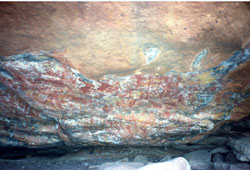
|
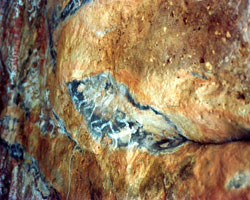
|
Site 2This cave painting, although still caged, is easier to decipher. The emu figures locked behind these bars are seemingly unconcerned that they are caged and continue their dancing unawares. There is an area reserved for black stencil handprints on a whiter ground that appears to have been done with participants of many ages. The highlight of this site, however, is an amazingly dense mural obviously created over many years by many artists, transforming the space into almost a living and breathing artwork. |
Site 3Green parrots fly overhead as we view this site of yellow ochre birds underneath and red lines above. There are a couple of less dense paintings of frogmen outside of the fences that are less distinguishable and distinguished but a pleasure to see outside of the grid. |
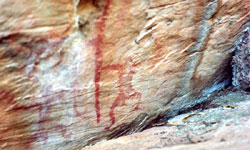
|
After this exhaustive three week ride on the aboriginal cave painting and engraving trail, Andy and I paused to reflect on all we had seen and to be thankful that our camper van made it back in from the outback. Perhaps the paintings acted as maps, or as a record of cyclical rather than spectacular time? A world where humans (and animals) walk in the same tracks as those of the ancestors and inscribe those tracks on the rock as a record of stability? Or could these sites have been created to tell other tribes/aboriginals that theyhad been there and to claim a type of ownership of the land? In other words, could the Aborigines have been marking their territory? Although the aboriginal concept of ownership is different since the people belong to the land more than the land belongs to the people (which leads to people overseeing rather than raping the land, but I digress). However, marking territory is marking territory. William Wright did it with his blue triangles, modern day graffiti writers do it with spray cans. The similarity with modern day graffiti cannot be ignored, nor can the connections with other ancient cave paintings such as in France and Spain. The heritage appears the same, but how does the Dreaming fit into it? The Dreaming is about illustrating the origins of the world, their world. Perhaps modern day graffiti is a bit like that too, with more emphasis on current dreams and practices than on ancient creation theories. Differences and similarities aside, I'll take representing dreams and myths over reality (whatever that is) any day, whether it be ancient myths of the Dreaming of Aboriginals or modern-day artists depicting their dreams and aspirations.
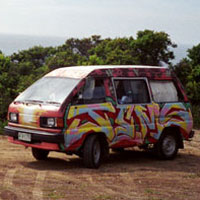 |
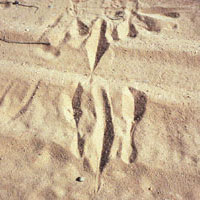 |
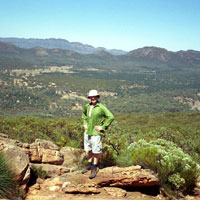 |
Aboriginal cave paintings and engraving can be found year round in
the Yourambulla Caves, Arkaroo Rock, Sacred Canyon, Mutawintji
National Park and Mount Grenfell Historic Site, in the Australian
Outback of South Australia and New South Wales. For more information
on these sites visit:
http://www.visitoutbacknsw.com.au/parks/grenfell.html
http://www.npws.nsw.gov.au/parks/outback/out005.html
http://www.hawkersa.info/places.htm#your
http://library.thinkquest.org/C0115620/text/Land.html
http://www.picknowl.com.au/homepages/rkfadol/art.htm
http://www.postcards.sa.com.au/features/sacred_rock.html
Amy Berk is a member of the stretcher crew currently spending a rainy summer in England slowly making her way back to San Francisco.